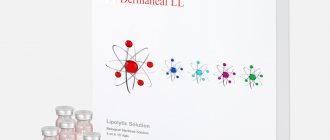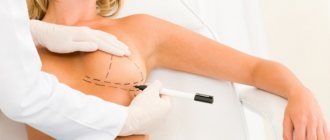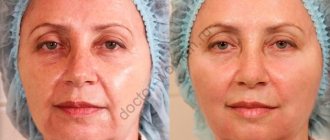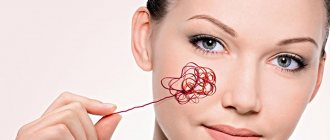Dermatovenereologist (cosmetologist)
Shukhman
Elizaveta Izrailevna
23 years of experience
Cosmetologist, member of the World Association of Interdisciplinary Anti-Aging Medicine (WOSIAM)
Make an appointment
Cellulite (lipodystrophy) is a persistent change in subcutaneous fat. Cellulite zones are characterized by the presence of clearly visible bumps and depressions. Skin relief defects progress with age. Patients complain of redness of the skin with slight stress. During the summer months, an uneven tan develops and areas of depigmentation appear. Lipodystrophy is localized on the forearms, thighs and buttocks.
Cellulite: what is it?
There is no unambiguous interpretation regarding this concept.
Some experts believe that these are dystrophic changes in the subcutaneous fat tissue, which cause disturbances in blood circulation and lymph outflow, resulting in irregularities, nodes, and a bluish color appearing on the surface of the skin.
There are body cosmetologists who share the concepts of “gynoid lipodystrophy” and “cellulite”. The first refers to a structural change in the subcutaneous fat of a non-inflammatory nature, which is popularly called “orange peel”, and the second is edema with hyperemia, the cause of which is diffuse serous inflammation.
There is a point of view that cellulite does not pose any health hazard. But that's not true. Retention of fluid by adipose tissue leads to compaction of the intercellular matrix, accumulation of metabolic products, the appearance of swelling, and compression of adjacent areas of connective tissue.
This reduces the level of elasticity of the skin, causes pain, and can provoke varicose veins and other undesirable consequences. Therefore, it is so important to prevent cellulite and begin its treatment in a timely manner.
Most often it is localized on the thighs (their outer and inner surfaces), on the buttocks, and also on the abdomen. Often its manifestations are present on the hands, where the fat layer is clearly visible. If you are overweight, uneven skin can even appear on your face.
Changes in connective tissue septa separating adipocyte lobules
Connective tissue septa formed by collagen and elastin fibers grow, thicken, and become coarser. This occurs due to a lack of oxygen and nutrients - and where will normal nutrition come from if the vessels are pinched by lobules?
And these hardened partitions, like an iron cage, resist the onslaught of swollen lobules. Soft fat bulges, and pits appear in places where the hard connecting strips adjoin the upper layer of the skin. This is how deformation of the skin surface occurs.
Cause of cellulite: pathogenesis and factors of occurrence
The pathogenesis of the phenomenon under consideration is complex. According to the hypothesis of Nurnberger and Muller, the origin of cellulite is explained by gender differences in the structure of the dermis of women. Structural changes in it (hypertrophy of subcutaneous fatty tissue, microcirculation disorders in tissues, compaction of connective tissue) lead to the formation of edema, tubercles, and looseness.
There are several factors that provoke such processes:
- Genetic predisposition;
- Excess weight;
- Hormonal imbalances;
- Pancreatic dysfunction;
- Diseases of the kidneys and adrenal glands;
- Pathologies of the urinary system;
- Depressive states;
- Tobacco smoking and addiction to alcoholic beverages;
- Poor nutrition;
- Lack of regular physical activity.
In order to choose the optimal method for treating cellulite, it is first recommended to consult an endocrinologist, gynecologist, and check the functioning of the abdominal organs and kidneys using ultrasound diagnostics.
Hormonal influences
Cellulite is a female problem also because it occurs under the influence of female sex hormones - estrogens. They provoke both the growth of fat cells and the coarsening of partitions - two main components of cellulite. Let's explain it in our fingers.
Estrogen increases the number of alpha receptors on adipocytes, and they, as we remember, block the release of fat from the cell into the bloodstream (and most of all alpha receptors on the stomach and thighs). But if that were the only thing, it would be just obesity, but no. Estrogens also make the connective tissue in the hypodermis thicker and coarser, creating a hard mesh frame through which fat sticks out like ham through a mesh.
Hormonal changes are especially pronounced in women at puberty and during pregnancy.
Cellulite also appears and progresses due to a decrease in the amount of thyroid hormones.
During menopause, the release of estrogen into the blood by the ovaries decreases. The body, in order to increase the formation of estrogen from male sex hormones, increases the amount of adipose tissue in the abdominal area.
Stages of cellulite
There are several options for grading the stages of cellulite. Let's look at the main ones.
The first is based on the pinch test, when a certain area of the body is squeezed with your fingers. Depending on the result obtained, the following are distinguished:
- Stage zero, when no tissue changes are noted;
- First: dimples and small irregularities are visible, but in a calm state they are not noticeable;
- Second: tubercles and pits are present during compression, as well as when a person is standing, but they are not present in a lying position;
- Third: cellulite nodules are visible in any condition and position.
The second classification of types of lipodystrophy is based on the reasons for its formation:
- Adipose type. Associated with subcutaneous deposition of excess fat, usually in the thighs and abdomen. Palpation does not cause pain, the tissues are soft;
- Edema type. It is clearly visible when the skin is squeezed; the distinctive symptom is heaviness in the legs, but does not cause discomfort when pressed;
- Fibrous type, when connective tissue grows, nodes are formed that are painful when squeezed. This type of cellulite is difficult to correct; it requires multi-stage treatment and a complex of therapeutic and cosmetic measures to eliminate it.
Sexual dimorphism of skin structure
It is believed that 90-95% of women are susceptible to cellulite. However, only 6% of men develop bumps on the skin. How so?
Very simple. Women are genetically predisposed to the formation of cellulite on the legs, buttocks and abdomen. And this is due to the structural features of adipose tissue and skin, namely:
- Women's adipocytes are larger than men's, meaning they can store more fat. The lobular structure of female adipose tissue looks lumpy under the skin.
- In the skin of women there are fewer collagen fibers, responsible for strength and elasticity, and more elastic fibers than men. This means that the female dermis is thinner and more elastic than the male dermis, so the tubercles under it are more noticeable. And with age, degenerative processes begin to occur in the skin, which weakens it even more.
- In women, connective tissue fibers are located perpendicular to the surface of the dermis, and in men - diagonally, creating a mesh frame. Therefore, in women, lobules of adipose tissue protrude unhindered, but in men, the skin texture does not change.
Most often in women, cellulite occurs on the butts and thighs. And there is an interesting explanation for this. In these zones, lipids break down more slowly. The fat cells themselves are larger here, more susceptible to the influence of hormones, and they have more alpha receptors (remember, we said that they are involved in the synthesis of fats). Why is this happening? Because the deposition of fat on the hips and buttocks is programmed in women by nature for the safe bearing of the fetus.
Methods for preventing and eliminating cellulite
Since this problem arises due to a whole range of different reasons, the methods for solving it should be multidirectional and include:
- diet;
- physical exercise;
- cosmetic procedures.
You need to start by making an appointment with a body cosmetologist, who will conduct an examination, collect anamnesis, and prescribe a course of treatment, taking into account the stage of cellulite and the characteristics of your health condition.
The main methods for getting rid of “orange peel” are:
- Massage (manual and hardware);
- Wraps;
- Fitness;
- Proper nutrition.
Let's pay more detailed attention to each point.
Massage for cellulite
Let's start with a massage. This is an effective way to eliminate fat deposits, restore skin firmness and elasticity, and shape your figure.
There are many massage techniques. Within the framework of our topic, first of all, it is worth mentioning anti-cellulite manual massage. It is usually intended to smooth and tone the skin on the legs. The technique for performing this massage is as follows: the massage therapist’s hand movements should be fast and include 50% rubbing and 50% squeezing. The impact is superficial. A course of at least 10 sessions is recommended.
Hardware methods for treating cellulite
Hardware methods - LPG and Endosphere - have also proven themselves well.
LPG is a vacuum-roller effect on body tissue. The technique was developed in France in the 80s of the 20th century. With the help of self-propelled rollers located in the handpiece, the skin fold is mechanically kneaded, which is captured by the vacuum. The whole body is massaged: the specialist moves the handpiece horizontally and vertically, and the rollers rotate in one direction or the other. The most problematic areas of the body (hips, butt and others) are treated with special attention.
Result of LPG massage:
- Removing excess fluid;
- Stimulation of lipolysis;
- Activation of blood circulation and lymph flow;
- Production of collagen in tissues.
All this leads to the fact that the skin is evened out, excess volumes and kilograms are lost, the silhouette becomes more toned. This type of massage requires a special elastic suit that protects the surface of the skin, making the procedure comfortable, and ensures hygiene. The standard course is 10 sessions, the duration of 1 session is 35 minutes in accordance with the protocol of the device manufacturer.
Endosphere therapy was developed by Italian scientists in the early 2000s. This is a method of compression microvibration transmitted to the body using a special device - a cylinder equipped with rotating spheres made of special silicone. The vibration of the spheres causes the deep layer of tissue to “work”, stimulating the work of mechanoreceptors (Merkel particles), thereby activating the process of lipolysis (fat breakdown) and the breakdown of fibrous compounds.
When carrying out the procedure, the cosmetologist changes the speed of movement of the handpiece and thereby sets the parameters of vibration of the spheres and their rotation, providing pressure on the body (“pump effect”). In this case, the specialist varies the intensity of the impact depending on the individual tasks of the patient.
Endosphere therapy is done directly on the skin, onto which massage oil is applied for better gliding of the spheres. Even if cellulite is only on the thighs, the procedure involves not only one or another leg, but also the body as a whole - otherwise the procedure will be ineffective.
This is a course technique, on average 6 to 12 sessions are required, each of which lasts 1 hour 15 minutes in accordance with the recommendations of the creators of the technology.
Endosphere Effect:
- Lymphatic drainage effect;
- Smoothing the skin surface (eliminating cellulite);
- Elimination of local fat deposits;
- Figure correction;
- Weight reduction.
By removing excess water, puffiness is relieved, the skin becomes dense and elastic, more toned.
These devices are recognized leaders in the field of body care.
Many people are interested in:
- Which one is better?
- How is LPG different from Endosphere?
In answering these questions, we must first say that these are two fundamentally different techniques of influence, as can be seen from their description. Secondly, which of these devices will be effective can only be decided by a cosmetologist after examining the patient, taking into account the medical history and the stage of cellulite. Third, a combination of these two methods may be required to achieve the desired effect.
As mentioned above, getting rid of cellulite requires an integrated approach. Therefore, it will be useful to combine massage with wraps, which have a beneficial effect on the quality of the skin. They can be of various types: based on oligo-elements (algae, for example), mud, cream. The temperature regime used is also different - there are hot wraps and cold ones.
At home, such procedures can be carried out only after consultation with a specialist: if cosmetics are used incorrectly, the timing of the procedure and other requirements are not followed, the disease can be aggravated.
How does cellulite wrap work?
A special composition is applied to the skin, then the body is wrapped in a thermal blanket, the desired temperature is set and after the allotted time the procedure ends. The temperature chosen by the cosmetologist should activate the effect of cosmetic products, due to which lymphatic drainage occurs, the functioning of blood vessels is normalized, the skin is nourished and becomes smoother.
Changes in microcirculation in the dermis
But the matter is not limited to external manifestations. Capillaries weaken, the nutrition of local tissues is disrupted. Blood and lymph stop circulating normally. The skin swells.
How is everything going?
Enlarged adipocytes put pressure on the vessels, which disrupts microcirculation. This means that the orderly and free movement of lymph and blood is difficult.
However, some scientists believe that the relationship is the opposite. First, difficulties arise with microcirculation, and because of this, adipocyte hypertrophy occurs.
What does impaired blood flow lead to? The exchange of oxygen and carbon dioxide slows down, waste products are not eliminated from the body in a timely manner. Toxins accumulate in swollen fat cells, encased in hardened septa.
What does impaired lymph flow lead to? In general, the purpose of the lymphatic system is to drain fluids circulating in the blood and return them to the circulatory system. And if the lymph flow does not perform its function well, the fluid stagnates and the tissues swell.
Prevention of cellulite.
To quickly get rid of cellulite, cosmetic methods alone are not enough. Competent physical activity and a balanced diet must be present.
As for playing sports, we recommend consulting a professional fitness trainer. He will develop a complex, taking into account the assigned tasks, and recommend an exercise that can be performed at home so that the process does not stop.
Nutrition should also be given special attention. If there is an imbalance in the diet, fats and carbohydrates predominate, then it needs to be reviewed, otherwise it will be difficult to remove the manifestations of cellulite. The basis of the daily menu should be easily digestible proteins, vegetables and fruits, herbs, and wholemeal bread.
What products will be useful?
- Poultry meat;
- Steamed vegetable side dishes;
- Seafood containing Omega-3 fatty acids;
- Fruits, preferably of local origin (not imported);
- Low-fat yogurt, kefir, cottage cheese;
- Soft-boiled eggs and “bag”;
- Grain bread;
- Vegetable salads seasoned with vegetable oil (olive, sunflower).
Foods to Avoid
- All canned food (no matter whether home-made or factory-made);
- Pork, lamb;
- All fast food in any form;
- Strong alcohol;
- Soda;
- Baked goods and white bread;
- All types of sausages, frankfurters, sausages.
Home care will also provide invaluable assistance in achieving your goal. Cosmetics stores offer an incredible amount of body care products, including those for fighting cellulite: creams, masks, serums, mixtures for wraps, gels, oils. To understand this variety and choose a worthwhile product, first consult a cosmetologist. He will select an effective option taking into account the characteristics of your skin.
You might be interested
Facelift without surgery? It's real.
Time dictates its own laws. Today, those who look well-groomed and young achieve success. The well-known proverb “You are greeted by your clothes” can be supplemented – and by your face too! But what to do if age takes its toll?











